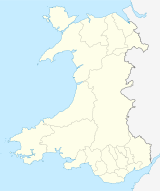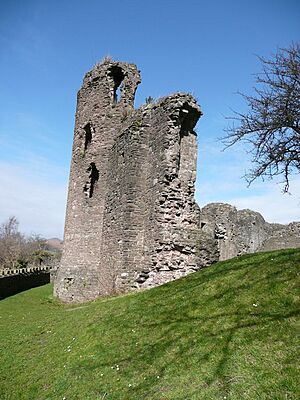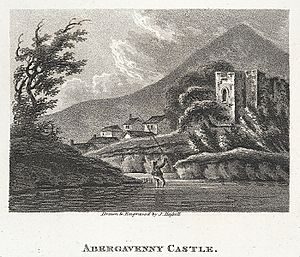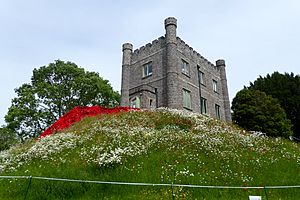Abergavenny Castle facts for kids
Quick facts for kids Abergaveny Castle |
|
|---|---|
| Abergaveny, Monmouthshire, Wales | |
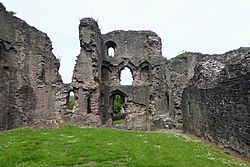
Interior of the surviving curtain wall and four-storey tower, looking west from inside the castle grounds
|
|
| Coordinates | 51°49′12″N 3°01′04″W / 51.82002°N 3.017647°W |
| Type | Castle |
| Site information | |
| Condition | Ruins |
| Site history | |
| Battles/wars | Glyndŵr Rising, 1404 |
|
Listed Building – Grade I
|
|
| Designated | 1952 |
Abergavenny Castle (Welsh: Castell y Fenni) is a ruined castle in the town of Abergavenny, Monmouthshire, Wales. A Norman lord named Hamelin de Balun built it around 1087.
This castle has a long and sometimes difficult history. It was the site of a famous event in 1175 where Welsh noblemen were killed. The castle was also attacked during the Glyndŵr Rising in the early 1400s. A historian from the 1500s, William Camden, said it was known for acts of betrayal more than any other castle in Wales.
Today, Abergavenny Castle is a Grade I listed building. This means it's a very important historic site.
Contents
Where is Abergavenny Castle?
The castle is just south of the town center. The Normans built it to watch over the River Usk and its valley. This location helped them guard against attacks from the Welsh people living in the nearby hills.
What Does the Castle Look Like?
Even though it's mostly in ruins now, Abergavenny Castle was once a strong fortress. It had a stone keep (a main tower), other towers, and a ditch for protection.
Inside the castle, there were buildings for the lord's family and his army. These included cellars, kitchens, a large hall, and a gatehouse. A strong curtain wall (an outer wall) surrounded the entire castle.
The most impressive part still standing is the high curtain wall, built in the 1100s. A building from the 1800s, called a lodge, was later built on top of the castle's motte (a large earth mound).
A Brief History of the Castle
Early Days: 11th to 14th Centuries
Around 1087, Hamelin de Balun, a Norman lord, started building the castle. At first, it had a wooden keep on top of an earth mound (the motte), protected by a ditch and a wooden fence called a palisade.
Soon after 1100, a stone keep replaced the wooden one. A wooden hall was also built on the western side.
The 1175 Event
In the 1160s, Henry Fitzmiles, the lord of Abergavenny, was killed. His lands and the castle then went to his daughter Bertha's husband, William de Braose. De Braose rebuilt parts of the castle, including the strong curtain wall you can still see today.
In 1175, De Braose invited Welsh leaders, including Seisyll ap Dyfnwal and his son, to the castle. He claimed it was for peace. However, De Braose had these men killed inside the castle, as revenge for Henry Fitzmiles' death.
This act led to trouble. In 1182, Seisyll's relatives attacked and burned Abergavenny Castle. De Braose was not there, but many of his men were taken hostage.
Rebuilding and Expansion
Around 1190, the castle was almost completely rebuilt using local Old Red Sandstone. This made it easier to defend. Five towers were added along the curtain walls, and a new keep was built.
For many years, the English and Welsh fought over control of the Welsh Marches, and the castle often changed hands. In 1215, King John of England even visited the castle.
During the 1200s and 1300s, the Hastings family expanded the castle further. They added western towers that had living spaces. Two towers, one round and one with many sides, were likely built between 1295 and 1314. At this time, taxes were collected to help build the town walls too.
Later Years: 15th to 17th Centuries
In 1404, during Owain Glyndŵr's rebellion, Welsh forces attacked and burned the town of Abergavenny. The castle's fortified gatehouse might have been built around this time.
After the 1400s, no lord lived at the castle full-time. During the English Civil War, King Charles I ordered the castle to be partly destroyed. This was done to stop his enemies, the Roundheads, from using it. Most of the castle buildings, including the stone keep, were ruined. Stones from the castle were later taken to build other structures.
18th and 19th Centuries
By the late 1700s, the castle ruins became a popular spot for visitors who enjoyed "picturesque" views. Paths were made within the castle walls for walking.
In 1819, Henry Nevill, 2nd Earl of Abergavenny, built a hunting lodge on top of the motte. It was a simple building, but it added to the castle's look.
Later in the 1800s, a formal public garden was created by William Nevill, 5th Earl of Abergavenny. This garden had great views of the Usk valley, pretty walks, and small shelters called gazebos. It is now on the National Register of Historic Parks and Gardens.
20th and 21st Centuries
Since 1952, the castle and the hunting lodge have been protected as Grade I and Grade II listed buildings. Other parts of the castle, like the outer wall, were listed in 2005.
Abergavenny Castle Museum
The castle's museum is located in the 1819 hunting lodge, which sits on top of the motte. Inside the museum, you can see interesting exhibits. These include a saddler's workshop and a Victorian Welsh farmhouse kitchen. It's a great place to learn about the history of the castle and the local area.


